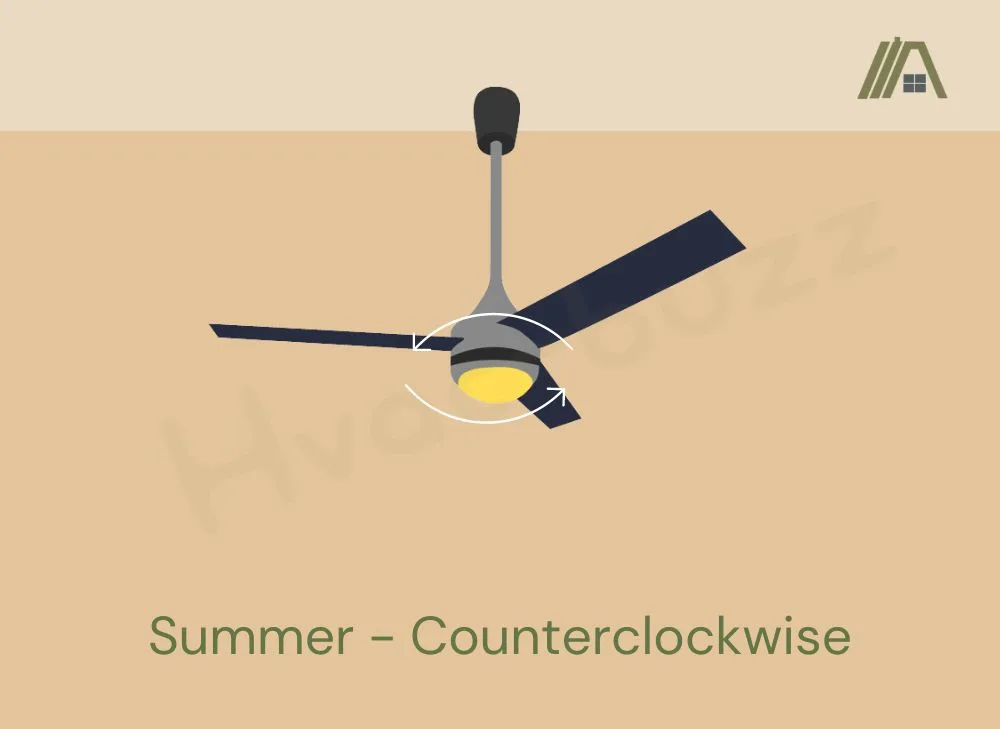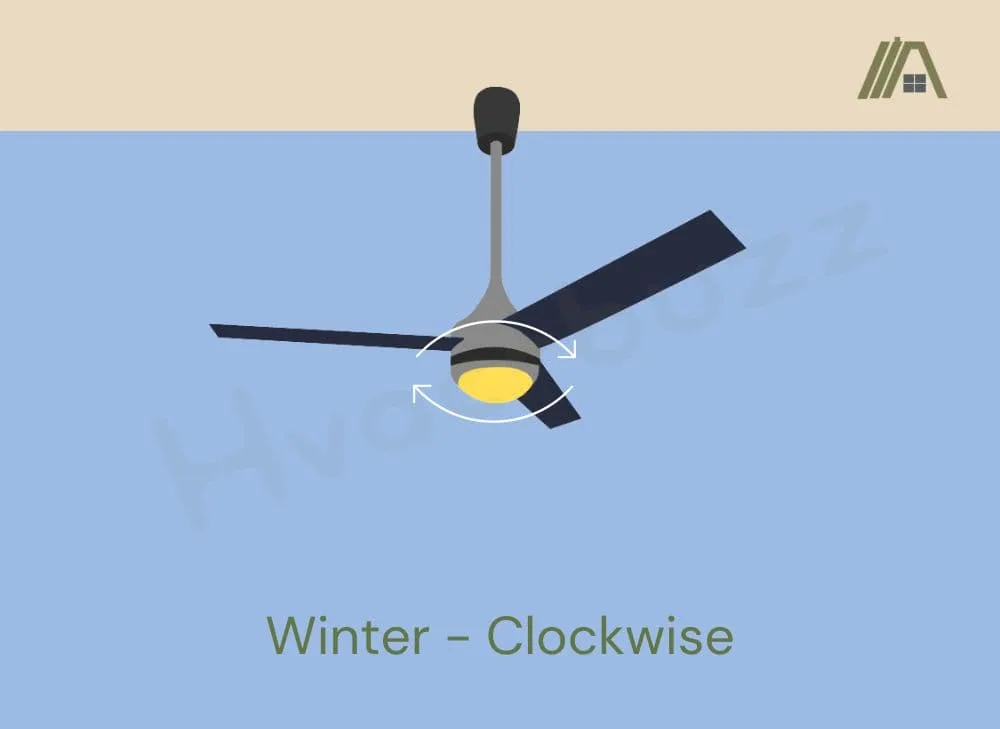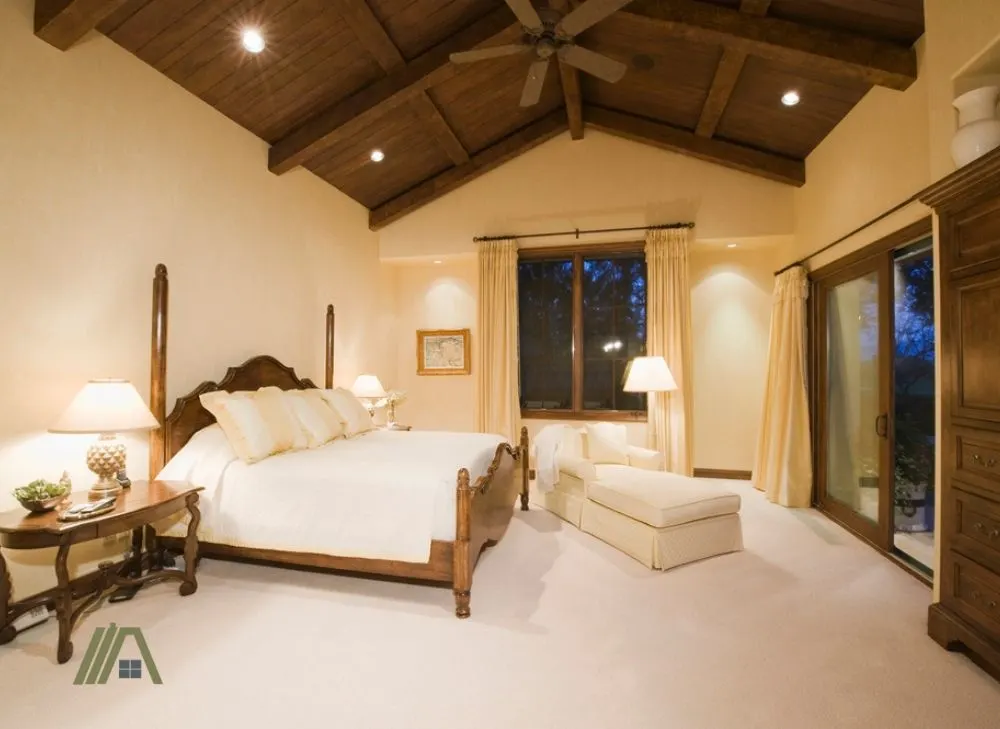Vaulted or cathedral ceilings have that je ne sais quoi factor. They are a statement in a space and can create a very different effect to standard height ceilings. However, with the design choice comes a few hitches in terms of your ceiling fan.
So, you have the tall ceiling you wanted. Now it’s about having to make the most out of your ceiling fixtures. There is, unfortunately, a best placement for a ceiling fan that is not tailored to particularly high ceilings, but you can try and work with a less than ideal installment height by making use of the direction settings.

Ceiling fan direction depends on how much the clearances differ from the recommendations. Slightly exceeding the distances means following the general rules for direction. However, significant ceiling heights make the counterclockwise (summer) mode more effective in both summer and winter.
Typical Ceiling Fan Direction
Summer
The summer mode or setting on your ceiling fan directs the blades in a counterclockwise direction. This means that the higher parts of the pitched blades are cutting through the air first. Thus, air is taken from above and around the fan and pushed downward by the blades.

The air channeled down through the fan is how we experience the cooling effect of a ceiling fan. When a fan blows air towards you, you can experience wind chill. This is the act of airflow blowing past your skin, which causes heat loss and makes you feel cooler.
This also means that wind chill is only effective if it is acting on you. A fan cannot mechanically cool a room like air conditioning.
Winter
In the winter mode or setting on your fan, the blades rotate in a clockwise direction. This means that the lower parts of the blades are leading. The purpose here is to pull air up towards the ceiling to force the warmer air that has risen to disperse down around the walls. By using the updraft, warm air can be distributed through the room.

In the same way that a ceiling fan does not actually generate cold air, it cannot produce warm air either. However, in the summer setting, we have the benefit of wind chill; in the winter mode, your fan will have limited effectiveness on its own.
To get the best out of the winter setting, you will need to use a heat source; then the fan can distribute heated air.
Effectiveness Limited with High Ceilings
The distance between the ceiling fan and the ceiling, floor, and walls is important for how effectively a fan can perform in both summer and winter mode.
If you were to follow the height of a vaulted/cathedral ceiling for installing the fan, this would hamper the downdraft that cools you, as well as the updraft that redistributes heat around the room.
Summer
A ceiling fan that sits too high above the floor is not effective. By the time the downdraft reaches you (if it does at all), it is so insignificant that it has no cooling abilities.
The wind chill fact relies on the speed of air blowing past you. Since ceiling fans cool you and not the room, if you are too far from the blades, the airflow loses most of its power before it reaches the occupied space, and you will experience little benefit from the fan in your vaulted/cathedral ceiling.
This is why extender rods are available—to cater to larger distances between your ceiling and floor. The closer the fan is to sitting within 8-9’ of the floor, the more effective it can function to cool you.
Winter
Similarly, the updraft and circulation of air in the winter mode has a limited reach. It will likely prove even less effective than the summer mode since the air movements are slower and less concentrated.
Will the fan still move warmer air down from the ceiling? Yes, but the natural process that causes warm air to rise will overpower the artificial force of the ceiling fan. This means that because of the ceiling height, the distance that the warm air is displaced won’t be long enough to ever reach you before it is once more naturally rising toward the roof.
What Is Considered Too High for Effectiveness?
As I mentioned earlier, the distance of the ceiling fan from the room’s shell is important. These clearances are the guidelines for getting the most optimal functioning from your fan, which is why I devoted an entire article to the topic of ceiling fan clearances.
When it comes to clearances, there is a range of acceptable distances that contains the optimal margins. If your ceiling is too high, but is just this side of the effective/not effective line, you can follow the typical rules for ceiling fan direction.

The trouble arises when your ceiling height puts you significantly beyond the clearances.
Downward Airflow Might Be Best
There is a general understanding within the world of ceiling fans that the summer mode is most effective and the reason we generally purchase the appliance. A ceiling fan on winter mode is most helpful when working with a heater or the HVAC system. Otherwise, its effect will hardly be noticeable.
If you want the most from your fan with a very high vaulted/cathedral ceiling, then keeping it on summer mode (air blowing downward) may be your best chance.
In summer, you will be circulating the air. This circulation helps reduce the air’s stillness, or staleness, that contributes to your perception of heat.
In winter, we are looking at a “prevention over cure” approach. With the downdraft of the summer mode, you might be able to prevent hot air from rising all the way to the top of the high ceiling with the downward airflow.
This could, essentially, “lower the ceiling”. This will keep the warmth in the room closer to you, which may make a difference; however, this will only be in effect in the area directly below the fan and still relies on external heat sources to be effective at warming you up.
Improve Chance of Effectiveness with Larger Fan
Larger fans typically have larger blades. This means that there is more surface area working to move the air, making the fan more effective for the extra room created by the higher ceiling.
Your fan will still need to fit in with wall clearances and the other clearances as far as possible to perform with any effectiveness. However, with a larger and more powerful fan, you have a better chance of combating the difficulties of a vaulted/cathedral ceiling.
In the summer, the more powerful fan will reasonably have a more powerful downdraft that can potentially reach you better. If the downdraft can reach you, you can benefit from wind chill.
In winter, the bigger, stronger fan has more potential for overpowering the natural process of rising air and forcing warm air further down into your space, where you have the chance to benefit from it.
What if the Fan Needs to Sit on the Sloped Part?
Ceiling fans can still be installed on sloped ceilings. You just need a special adapter that can accommodate the angle and a long-enough downrod to prevent the blades from scraping on the lower part of the slope.

